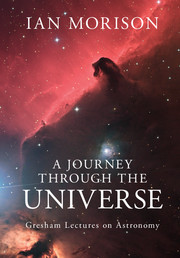Book contents
- Frontmatter
- Dedication
- Contents
- Preface
- Acknowledgements
- 1 Watchers of the skies
- 2 Our Sun
- 3 Aspects of our Solar System
- 4 The rocky planets
- 5 The hunt for Planet X
- 6 Voyages to the outer planets
- 7 Harbingers of doom
- 8 Impact!
- 9 Four hundred years of the telescope
- 10 The family of stars
- 11 Aging stars
- 12 The search for other worlds
- 13 Are we alone? The search for life beyond the Earth
- 14 Our island Universe
- 15 Wonders of the southern sky
- 16 Proving Einstein right
- 17 Black holes: no need to be afraid
- 18 It’s about time
- 19 Hubble’s heritage: the astronomer and the telescope that honours his name
- 20 The violent Universe
- 21 The invisible Universe: dark matter and dark energy
- 22 The afterglow of creation
- 23 To infinity and beyond: a view of the cosmos
- Index
- Plate section
- References
17 - Black holes: no need to be afraid
Published online by Cambridge University Press: 05 October 2014
- Frontmatter
- Dedication
- Contents
- Preface
- Acknowledgements
- 1 Watchers of the skies
- 2 Our Sun
- 3 Aspects of our Solar System
- 4 The rocky planets
- 5 The hunt for Planet X
- 6 Voyages to the outer planets
- 7 Harbingers of doom
- 8 Impact!
- 9 Four hundred years of the telescope
- 10 The family of stars
- 11 Aging stars
- 12 The search for other worlds
- 13 Are we alone? The search for life beyond the Earth
- 14 Our island Universe
- 15 Wonders of the southern sky
- 16 Proving Einstein right
- 17 Black holes: no need to be afraid
- 18 It’s about time
- 19 Hubble’s heritage: the astronomer and the telescope that honours his name
- 20 The violent Universe
- 21 The invisible Universe: dark matter and dark energy
- 22 The afterglow of creation
- 23 To infinity and beyond: a view of the cosmos
- Index
- Plate section
- References
Summary
Black holes seem to have a reputation for travelling through the Galaxy ‘hoovering up’ stars and planets that stray into their path. It’s not really like that. If our Sun were a black hole, we would continue to orbit just as we do now – we just would not have any heat or light. Even if a star were moving towards a massive black hole, it would be far more likely to swing past – just like the fact very few comets hit the Sun but fly past to perhaps return again. So, if you are reassured, then perhaps we can consider …
What is a black hole?
If one projected a ball vertically from the equator of the Earth with increasing speed, there would come a point, when the speed reaches 11.2 km/s, when the ball would not fall back to Earth but would escape the Earth’s gravitational pull. This is the Earth’s escape velocity. If either the density of the Earth was greater (so its mass increased) or its radius smaller (or both) then the escape velocity would increase. Pierre-Simon Laplace realised that, if the mass within a given volume were sufficiently high, the escape velocity would exceed that of light and so not even light could escape. Much later, the eminent American physicist John Wheeler came up with name ‘black hole’ for such an object.
- Type
- Chapter
- Information
- A Journey through the UniverseGresham Lectures on Astronomy, pp. 239 - 254Publisher: Cambridge University PressPrint publication year: 2014



